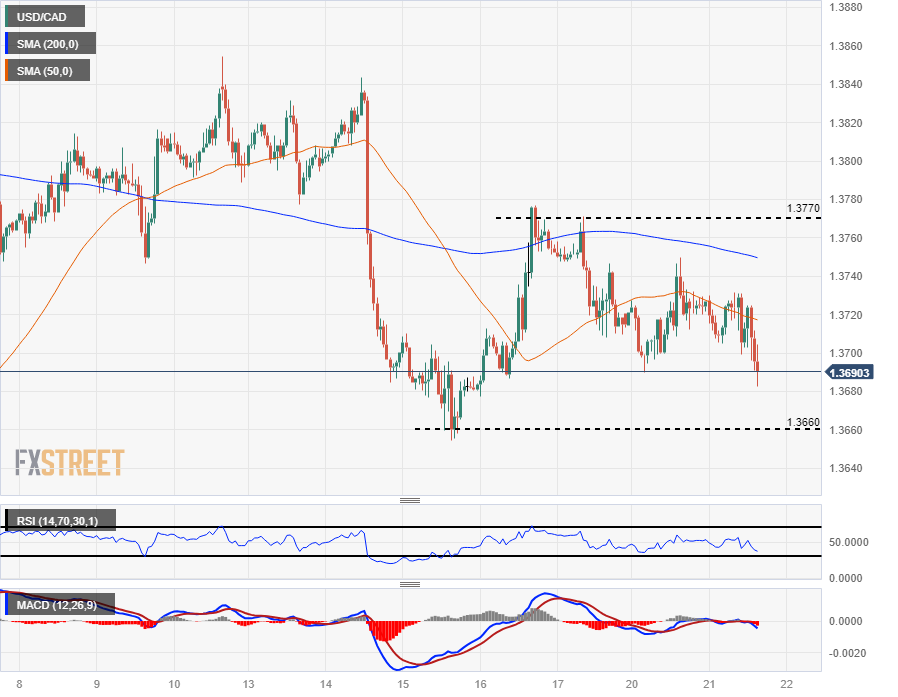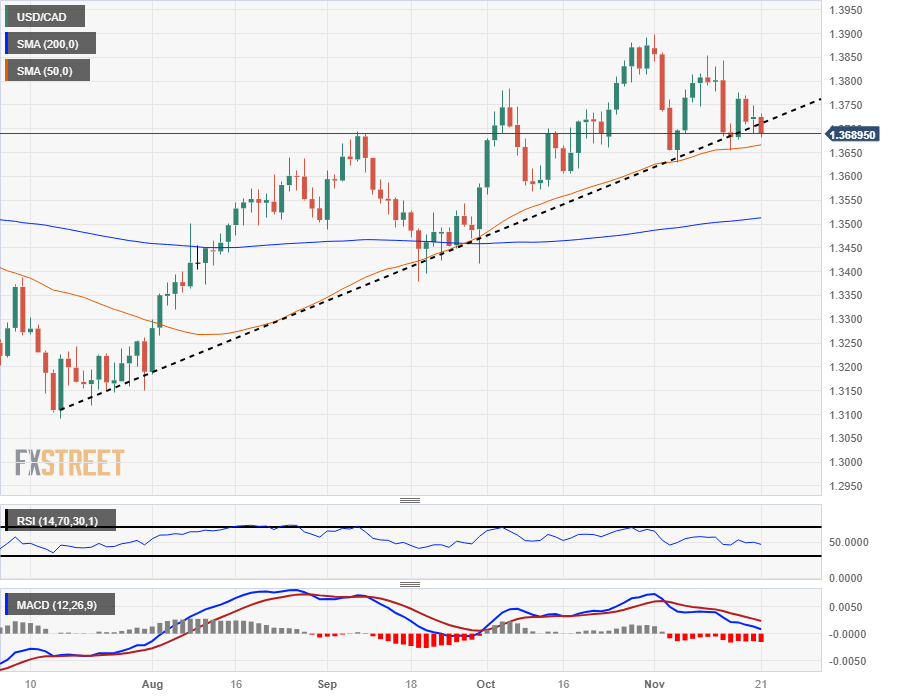Canadian Dollar trying to capture gains but seeing limited upside after Canada CPI misses the mark

- The Canadian Dollar is seeing higher bids on Tuesday, but momentum remains thin.
- Fed’s latest Meeting Minutes are due in the early afternoon.
- Crude Oil is grinding sideways above $77.00, limiting CAD support.
The Canadian Dollar (CAD) is looking for further upside against the US Dollar (USD). Loonie momentum remains limited with Crude Oil spinning in place and investors focusing on the Federal Reserve’s (Fed) latest Meeting Minutes due at the top of the US market session.
Canadian Consumer Price Index (CPI) inflation figures missed expectations in the annualized headline number, and the Bank of Canada’s (BoC) Core CPI was mixed between the monthly and annual results.
Daily Digest Market Movers: Canadian Dollar finds little legroom, moves remain tight
- Canadian headline CPI inflation in October missed expectations in the annualized figure, coming in at 3.1% versus the forecast of 3.2%, backsliding from the previous 3.8%.
- MoM CPI printed as expected at 0.1%, rebounding slightly from September’s -0.1% decline.
- Core CPI lurched higher to 0.3% against the previous -0.1%.
- The BoC’s own YoY Core CPI watchlist shed some weight in October, coming down to 2.7% from 2.8%.
- Markets are turning to focus on the Fed’s upcoming Meeting Minutes release, due at 14:00 EST.
- An overly hawkish Fed could throw jitters through the market.
- Crude Oil is churning in the $77.00/barrel region, providing little support for the Loonie.
Canadian Dollar price today
The table below shows the percentage change of Canadian Dollar (CAD) against listed major currencies today. Canadian Dollar was the strongest against the Euro.
| USD | EUR | GBP | CAD | AUD | JPY | NZD | CHF | |
| USD | 0.05% | -0.26% | -0.29% | -0.05% | -0.40% | -0.41% | -0.24% | |
| EUR | -0.04% | -0.30% | -0.33% | -0.12% | -0.46% | -0.45% | -0.27% | |
| GBP | 0.26% | 0.31% | -0.03% | 0.19% | -0.13% | -0.15% | 0.02% | |
| CAD | 0.30% | 0.34% | 0.04% | 0.25% | -0.11% | -0.12% | 0.07% | |
| AUD | 0.05% | 0.08% | -0.19% | -0.22% | -0.33% | -0.34% | -0.15% | |
| JPY | 0.40% | 0.46% | 0.15% | 0.11% | 0.31% | -0.02% | 0.17% | |
| NZD | 0.42% | 0.44% | 0.15% | 0.12% | 0.34% | 0.01% | 0.15% | |
| CHF | 0.23% | 0.28% | -0.04% | -0.07% | 0.16% | -0.17% | -0.18% |
The heat map shows percentage changes of major currencies against each other. The base currency is picked from the left column, while the quote currency is picked from the top row. For example, if you pick the Euro from the left column and move along the horizontal line to the Japanese Yen, the percentage change displayed in the box will represent EUR (base)/JPY (quote).
Technical Analysis: Canadian Dollar struggles to capitalize but looks for further gains against the US Dollar
The Canadian Dollar (CAD) is on the rise against the US Dollar (USD) in Tuesday’s trading, but topside momentum remains limited and the USD/CAD is seeing hesitation after slipping below the 1.3700 handle.
The pair remains capped on the low end after catching a downside bounce from the 200-hour Simple Moving Average (SMA) last week.
The short-term technical barriers for intraday trading will be last week’s low bids near 1.3660 and the USD/CAD’s bearish rejection of the 200-hour SMA at 1.3770.
Tuesday’s bearish action sees the pair experimenting with a downside break of a bullish trendline from July’s swing low into the 1.3100 handle. Technical support is stacked from the 50-day SMA near 1.3665 and the 200-day SMA rising from 1.3500.
USD/CAD Hourly Chart
USD/CAD Daily Chart

Fed FAQs
Monetary policy in the US is shaped by the Federal Reserve (Fed). The Fed has two mandates: to achieve price stability and foster full employment. Its primary tool to achieve these goals is by adjusting interest rates.
When prices are rising too quickly and inflation is above the Fed’s 2% target, it raises interest rates, increasing borrowing costs throughout the economy. This results in a stronger US Dollar (USD) as it makes the US a more attractive place for international investors to park their money.
When inflation falls below 2% or the Unemployment Rate is too high, the Fed may lower interest rates to encourage borrowing, which weighs on the Greenback.
The Federal Reserve (Fed) holds eight policy meetings a year, where the Federal Open Market Committee (FOMC) assesses economic conditions and makes monetary policy decisions.
The FOMC is attended by twelve Fed officials – the seven members of the Board of Governors, the president of the Federal Reserve Bank of New York, and four of the remaining eleven regional Reserve Bank presidents, who serve one-year terms on a rotating basis.
In extreme situations, the Federal Reserve may resort to a policy named Quantitative Easing (QE). QE is the process by which the Fed substantially increases the flow of credit in a stuck financial system.
It is a non-standard policy measure used during crises or when inflation is extremely low. It was the Fed’s weapon of choice during the Great Financial Crisis in 2008. It involves the Fed printing more Dollars and using them to buy high grade bonds from financial institutions. QE usually weakens the US Dollar.
Quantitative tightening (QT) is the reverse process of QE, whereby the Federal Reserve stops buying bonds from financial institutions and does not reinvest the principal from the bonds it holds maturing, to purchase new bonds. It is usually positive for the value of the US Dollar.
